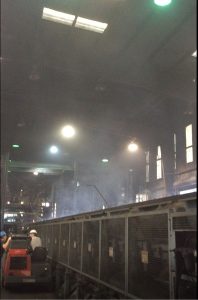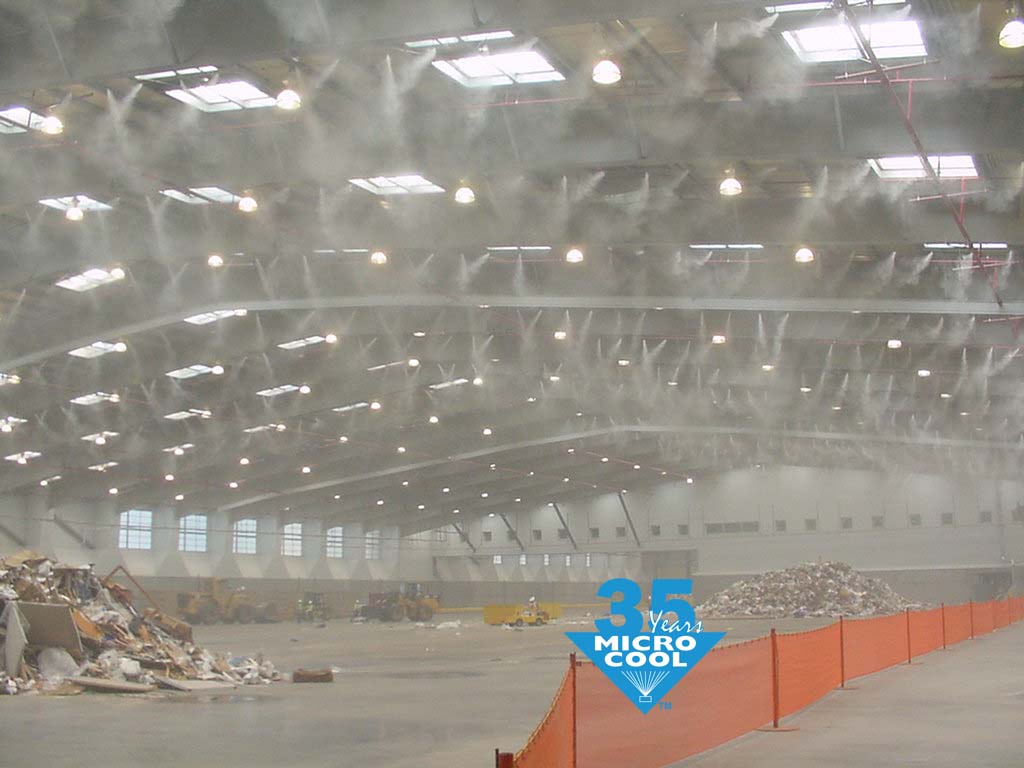An atomized fog system can control dust for many factory, waste management and production environments without over-wetting the environment like other mist systems. Given the smaller particle size, fog effectively tackles dust particles, containing the ‘cloud’ effect dust can create.
Mist Systems Effectively Reduce Dust
Summer can be a time when dust plays a larger role given dryer environmental conditions. The EPA’s ‘Waste Transfer Stations: A Manual for Decision-Making’ recommends mist systems to maintain adequate air quality caused by dust & odor: ‘Water-based dust suppression (misting or spray) systems used to “knock down” dust. Different types of systems are available. They typically involve a piping system with an array of nozzles aimed to deliver a fine spray to the area where dust is likely to be generated (e.g., over the surge pit). They typically are actuated by station staff “on demand” when dust is generated. Dust suppression systems can operate using water only or can have an injection system that mixes odor-neutralizing compounds (usually naturally occurring organic extracts) with the water. These dual purposes systems effectively control both dust and odors.'(1)
OSHA Respirable Silica Dust Standard
For General Industry & Maritime
OSHA’s Respirable Silica Dust Standard went into affect June 23, 2018 for General Industry & Maritime. Many businesses have been making strides toward compliance utilizing mist systems for overhead and targeted sources of dust as part of a compliance and engineering standard. 
What is Silica?
According to OSHA: Crystalline silica is a common mineral found in the earth’s crust. Materials like sand, concrete and mortar contain crystalline silica. It is also used to make products such as glass, pottery, ceramics, bricks and artificial stone.(2) Environments that employ processes such as grinding, sawing, sanding, drilling or blasting can kick up silica dust that is fine enough to be inhaled. Health is adversely affected by respiring this dust. About 2.3 million people in the U.S. are exposed to silica at work.
Which Industries Are Affected?
Exposure to respirable crystalline silica can occur in industry settings such as foundries, abrasive blasting operations, paint manufacturing, glass and concrete product manufacturing, brick making, china and pottery manufacturing, manufacturing of plumbing fixtures, and many construction activities including highway repair, masonry, concrete work, rock drilling and tuck-pointing. New uses of silica continue to emerge. These include countertop manufacturing, finishing and installation and hydraulic fracturing in the oil and gas industry.(3)
Dust Control | MicroCool IBEX Pump | Systems For MRF, Waste Transfer | Photos
Can we help design a system to control dust for your operation?
phone. 1-800-322-4364 or 1-760-322-1111 | email. info at microcool.com
References used for this post:
(1) United States. Environmental Protection Agency—Office of Solid Waste & Emergency Response. Waste Transfer Stations: A Manual For Decision Making. Washington, D.C.: 2002, page 40. Retrieved June 1, 2018. https://www.epa.gov/sites/production/files/2016-03/documents/r02002.pdf
(2) United States. Department of Labor—Occupational Safety and Health Administration. Safety and Health Topics: Silica. Washington, D.C. 2018. Retrieved June 13, 2018. https://www.osha.gov/dsg/topics/silicacrystalline/
(3) United States. Department of Labor—Occupational Safety and Health Administration. Small Entity Compliance Guide for the Respirable Crystalline Silica Standard for General Industry and Maritime. Washington, D.C. 2018, page 35. Retrieved June 13, 2018. https://www.osha.gov/dsg/topics/silicacrystalline/

